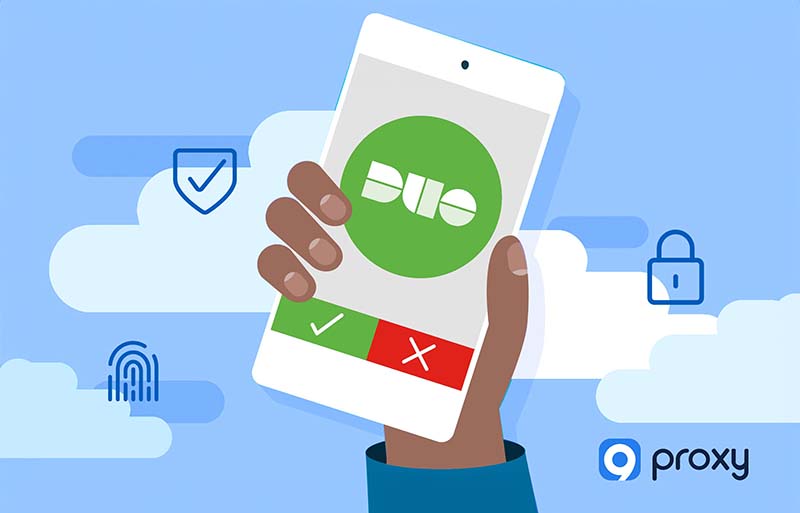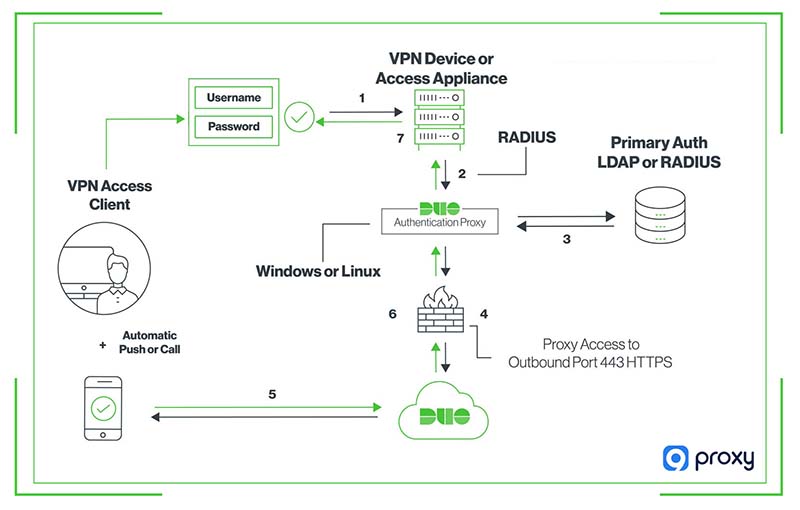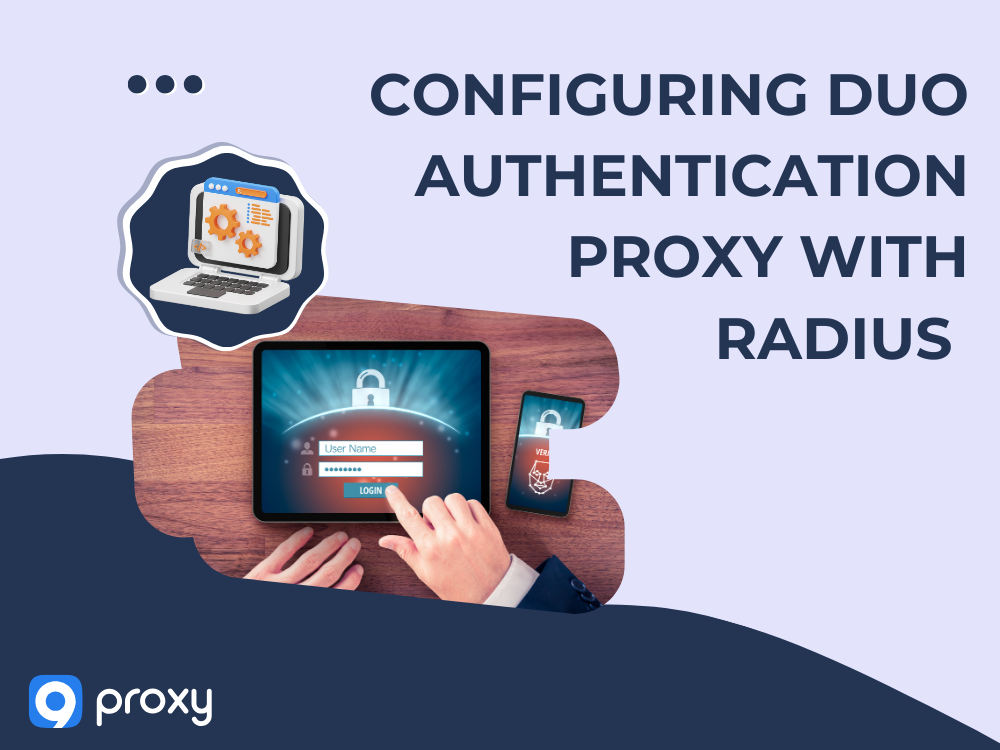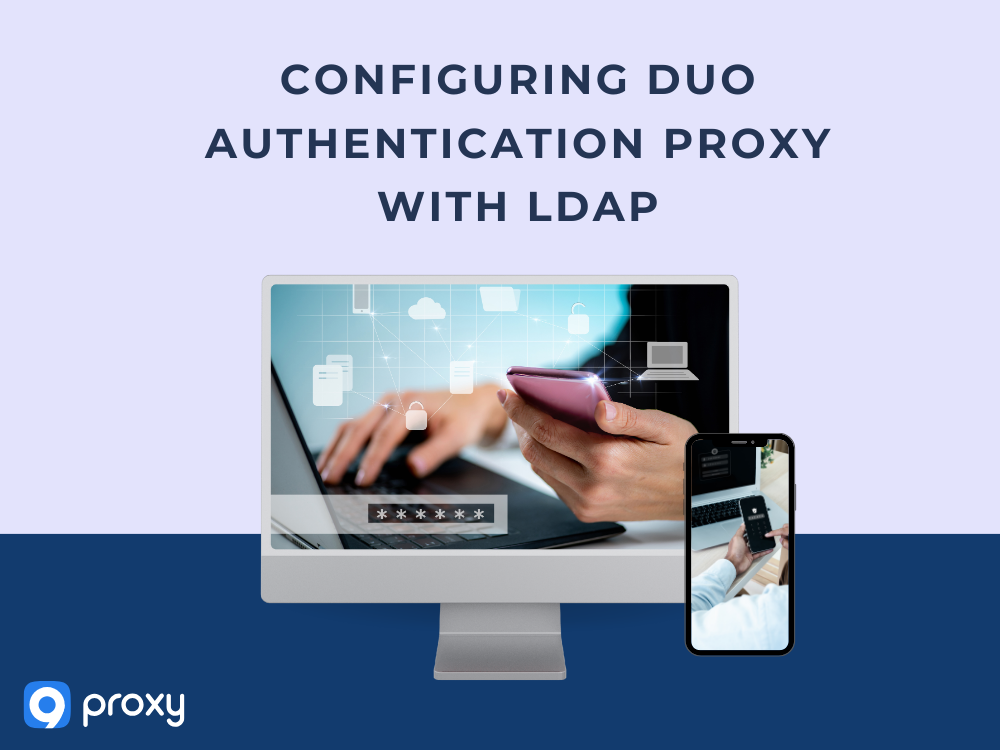Duo Authentication Proxy: Secure, Simple, Essential
Strengthening your network's defenses is a critical step in safeguarding against the ever-evolving digital threats. In this comprehensive analysis, let's explore the potential of the "Duo Authentication Proxy”, illustrating its integral role in seamlessly incorporating two-factor authentication and revolutionizing your organization's security protocols.
What is Duo Authentication Proxy?
The Duo Authentication Proxy, a sophisticated solution presented by Duo Security - a Cisco subsidiary - facilitates two-factor authentication for local devices and applications through RADIUS or LDAP protocols. It conducts primary authentication by interfacing with an extant LDAP directory or RADIUS authentication server, subsequently engaging with Duo to execute secondary authentication.
Furthermore, the Duo Authentication Proxy is an indispensable element for the incorporation of Active Directory or OpenLDAP users into Duo via synchronization. It also facilitates Active Directory authentication for Duo Single Sign-On and possesses the capability to function as an HTTP proxy for assorted systems requiring communication with Duo's cloud service.

How Does Duo Authentication Proxy Work?
When a device or application sends an authentication request, it goes to the Authentication Proxy. This proxy first checks the request with a known LDAP directory or a RADIUS server to confirm the basic credentials. After this primary check, the proxy connects with Duo for an additional layer of verification. The user gains access only after successful checks at both levels.
From a technical viewpoint, the connection between the Authentication Proxy and Duo occurs over TCP port 443. For those overseeing firewall settings: be cautious about using rules that depend on specific destination IP addresses to limit access to Duo. Duo's addresses might change to keep their service consistently available.
The Duo Authentication Proxy is versatile and has other important functions. It's vital for transferring users from Active Directory or OpenLDAP into Duo. It also helps with Active Directory checks for Duo's Single Sign-On feature. Plus, this proxy can act as an HTTP intermediary for systems needing to speak with Duo's online platform.

Benefits of Using Duo Authentication Proxy
Here are some benefits of using Duo Authentication Proxy:
Two-factor Authentication
Duo Authentication Proxy enhances your network's security by introducing two-factor authentication. This means when devices or applications in your network seek access, they have to pass through not just one, but two security checkpoints. By integrating with systems like RADIUS or LDAP (which can be thought of as digital directories where user credentials are stored), it ensures that any potential unauthorized access is deterred.

Integration with Existing LDAP or RADIUS Servers
One of the significant advantages of the Duo Authentication Proxy is its ability to integrate smoothly with your existing LDAP or RADIUS servers. This ensures that you can add Duo's robust security features without overhauling or replacing your current authentication systems. In simpler terms, it's like upgrading your house's security without changing its foundation.
Secondary Authentication with Duo
After the initial security check against your local directories (LDAP or RADIUS), the Authentication Proxy collaborates with Duo for a second layer of verification. This double-check system guarantees that only those who have the right to access your network can do so, providing peace of mind.
Importing Users into Duo
Managing user data across your network becomes a breeze with the Duo Authentication Proxy. It's an essential tool that allows for seamless synchronization or transfer of user data from systems like Active Directory or OpenLDAP directly into Duo. Think of it as a bridge that ensures your user data flows smoothly between systems.

HTTP Proxy
Beyond its authentication roles, the Duo Authentication Proxy can also operate as an HTTP proxy. In non-technical terms, it can stand in as a mediator, helping other systems in your setup communicate effectively with Duo's online services. This functionality means smoother and more integrated operations for your network.
Easy to Install And Configure
Even if tech isn't your strong suit, the Duo Authentication Proxy is user-friendly. It's designed for straightforward installation on both Windows and Linux servers. And once it's up and running, its configuration is intuitive. Just remember to always follow best practices and guidelines when setting up any security tool to ensure optimal protection.
Configuring Duo Authentication Proxy with RADIUS
Duo Authentication Proxy boosts your security by adding a second layer of authentication. In simpler terms, it ensures a double-check before granting access. If you're using RADIUS - a system that manages who gets to access your network - you can integrate Duo for this enhanced security. This guide will walk you through this process.

Step 1. Installation:
Install the Duo Authentication Proxy on your Windows or Linux server.
Step 2. Configuration:
- Find the authproxy.cfg file in the conf directory of where you installed Duo Authentication Proxy.
- Update this file by adding your specific authentication and application details. This step is crucial to starting the Duo Authentication Proxy service.
Step 3. Integrating with RADIUS:
- For Duo to work with your RADIUS system, first, set up a local Duo proxy service inside your network.
- This local service will act as a bridge. It will handle incoming RADIUS requests, check with your existing local directories like LDAP/AD or another RADIUS server, and finally, liaise with Duo's online service for that second layer of authentication.
Step 4. Adjusting Configuration for Different RADIUS Clients:
If you're using different types of RADIUS clients, include these sections in your configuration:
- [radius_server_auto] section
- [radius_client] section
In the [radius_server_auto] section, add:
- ikey: Your unique Duo integration key. You can find this in the Duo Admin Panel's application details page.
- skey: Your Duo secret key, also located in the same details page.
- api_host: This is the address of the Duo API endpoint.
- radius_ip_1: Your RADIUS server's IP address.
- radius_secret_1: A shared secret key between Duo and your RADIUS server.
- client: Specify the RADIUS client section for this setup.
- port: Define which port the Duo Proxy will use to receive RADIUS requests.
For the [radius_client] section, add:
- host: Your RADIUS server's IP address.
- secret: The shared key between Duo and your RADIUS server.
- pass_through_all: Set this to "true" if you want all RADIUS attributes to be sent to the main authentication server.
Step 5. Launching the Service:
On Windows, you can start the Duo Authentication Proxy service by using the authproxyctl start command in an elevated Command Prompt. Alternatively, open the Windows Services console and find "Duo Security" in the list to start it.
Step 6. Testing Your Setup:
Ensure everything is working as it should. Try logging in with a device or app that uses the Duo Authentication Proxy for authentication. If everything is set up correctly, you'll undergo the two-step authentication process.
Configuring Duo Authentication Proxy with LDAP
Duo Authentication Proxy is a security tool designed to enhance your network's protection. When integrated with LDAP—a directory service used to store and retrieve user information—it ensures a robust two-step verification. Let's guide you through the setup process.

Step 1. Installation:
Begin by installing the Duo Authentication Proxy on your Windows or Linux server.
Step 2. Configuration:
- Navigate to the authproxy.cfg file found within the conf directory of where Duo Authentication Proxy was installed.
- Populate this file with your specific authentication and application details. Completing this is vital for the next steps.
Step 3. HTTP Proxy Setup (Optional):
If you wish to use an HTTP web proxy to connect to Duo: under the [main] section in the configuration file, introduce the http_proxy_host option. Here, specify the hostname or IP address of your desired HTTP proxy.
Step 4. LDAP Server Configuration:
In the [ldap_server_auto] section, input the following:
- ikey: Think of this as a unique identifier. You can locate it within the Duo Admin Panel under your application's details.
- skey: This is another unique code, your Duo secret key. Also found in the Duo Admin Panel.
- api_host: The address to reach the Duo API.
- failmode: In rare cases when Duo's service isn't reachable, this option decides how to react. Setting it to "safe" lets users log in without Duo's verification.
- client: Mention the LDAP client section relevant for this setup.
Step 5. LDAP Client Configuration:
Within the [ldap_client] section, provide:
- host: The address (IP or hostname) of your LDAP server.
- port: The specific port your LDAP server operates on.
- search_dn: This is a distinguished name (DN) in LDAP that represents a user or group's location within the directory.
- username_attribute: The LDAP attribute which corresponds to the user's name.
- ssl_ca_certs_file: A pathway to the certificate file ensuring a secure connection.
- ssl_cert_file & ssl_key_file: Both pathways lead to files that further secure your connection. The former is your certification file, and the latter is its corresponding key.
Step 6. Launching the Service:
For Windows users, initiate the Duo Authentication Proxy service with the authproxyctl start command in an elevated Command Prompt. Alternatively, you can access the Windows Services console and select "Duo Security" from the list.
Step 7. Validation:
It's always good to double-check. Test your setup by trying to log in on a device or application that's connected to the Duo Authentication Proxy. If everything's in order, you'll experience the two-step verification process.
FAQ
Where can I get help if I face issues with the Duo Authentication Proxy?
Consult Duo's documentation, contact Duo Support, or check community forums.
Does Duo Authentication Proxy support high availability?
Yes, deploy multiple Duo Authentication Proxy instances for load balancing and failover.
Does Duo Authentication Proxy support logging and monitoring?
Yes, it has detailed logging compatible with standard log management tools.
How do I update the Duo Authentication Proxy?
Download the latest version from Duo's website and follow their update documentation.
Do I need any special hardware to run Duo Authentication Proxy?
No, it works on standard servers, both physical and virtual. Duo offers system requirements for best performance.
Conclusion
In conclusion, the "Duo Authentication Proxy" exemplifies the progressive strides made in the realm of secure authentication methodologies. This pivotal instrument not only streamlines but also robustly enhances authentication procedures, thereby establishing itself as an indispensable resource for organizations.
At 9Proxy, our fervor lies in meticulously examining technological solutions such as these, with the aim of elucidating their intricacies for our audience. Eager to garner further insights? We invite you to explore our plethora of blogs and remain abreast of the latest technological developments with 9Proxy.
Get Newsletters About Everything Proxy-Related